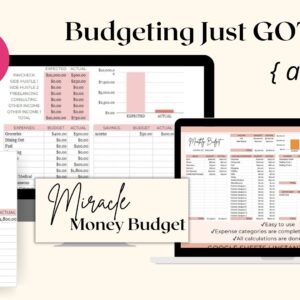
Most people spend a large portion of their budget on food. In fact, the US Bureau of Labor Statistics states that the average American household spends around $320 every month on groceries alone.
The truth is what we spend in a month at the grocery store can fluctuate dramatically. You could spend $200 per month to feed your family of four or could easily spend $1,000.
With all that inconsistency, it can be easy to blow your budget for groceries. If you find that you’re constantly spending more than you’ve budgeted for groceries, following these five hacks can help you save money on groceries.
Know the markdown schedule.
Whether you choose to shop at one or multiple stores for groceries, knowing each markdown schedule is critical in saving money.
Timing is everything. Some stores do markdowns first thing in the morning, some later at night. There are even some grocery stores who do multiple markdowns during the day. Be sure to clarify the times your stores does it’s reducing.
Most stores, not all, will do markdowns in different departments on different days. It is best to speak with someone in each department to get to know their price-reducing schedule.
Go into the stores as little as possible.
That’s right, physically STAY OUT of the grocery store as much as you can. With options like delivery and curbside pickup, avoiding going in as never been easier.
So why should you try to stay out of the grocery store? Because it is so easy to walk up and down each aisle, adding unnecessary things to your cart, even if it’s not on your list. We have all been there!
Look into options like Instacart and Shipt for delivery right to your door. Or check into your store’s online ordering with drive-up pickup.
If you DO go into a store…..
- Don’t Shop The Aisles At Eye Level – Eye-level means expensive, so buy products higher or lower on shelves.
- Stack as many rewards as possible- Each store is different, but check your grocer’s policies on stacking coupons
- Use online savings apps- Good apps to download are Starsavings, Ibbotta, and Fetch
- Look for Discount Bins- Many stores do a discount bin, aisle or section with clearance items.
- Shop The Local Farmers Market-
- Buy in season- Fruits and vegetables always costs more when out of season
- Use everything- This is where creativity comes in! Buy a whole chicken and use it for different meals.
- Don’t throw food away- Again, get creative!
- Make a budget – And stick to it! Your budget should always include a few extra stockpile items. Especially if they are on sale.
- Use cash- Research has shown that people who use cards waste 12%-18% more money than people who use cash.
- Stockpile- Don’t stockpile unless it’s an item you and your family use and things that don’t go bad!
- Make things last as long as possible- Look for recipes that include ingredients that don’t go bad quickly.
- Eat BEFORE you do shopping- Never shop on an empty stomach, it is a guarantee you will buy unnecessary things!
- Eliminate Unnecessary Ingredients – SO if a recipe calls for some strange spice that costs $14.99, then it’s not a recipe to use. Especially if it’s a spice, you know, you will never use!
- Buy Generic- Most of the time, these items have the same ingredients AND costs less!
- Don’t buy bottled water or other beverages-
- Avoid Pre-Cut and Prepackaged Items- You are paying for convenience!
- Simplify your meals- The more ingredients you can reuse, the better. Remember, it’s all about creativity.
- Use what you already have before you buy more- Just because it’s on sale doesn’t mean you need it! Especially if it is an item that will expire.
- Don’t buy toiletries at the grocery store- Because big box stores carry more inventory of these items, they are cheaper than at the grocery store!
- Buy less meat in general- Buying the whole animal is less expensive than what you buy at the grocer. Since this isn’t realistic for everyone, you can save a lot of money by buying less meat.
- Stretch your meat with oats, rice, breadcrumbs, or similar fillers- Use breadcrumbs or rice to make meatballs, thus expand the number of meals you use ground beef in!
- Weigh your produce- Items like a head of lettuce or a bag of carrots are one price, so weighing them will help you find the heaviest in the inventory!
- Use price matching – When available, price matching will help you save money on groceries. Again you will need to consult with your grocer for their policy on price matching.
Shop Alone.
Shopping with others (spouse, significant other, kids, etc.) should be avoided as much as possible. When you don’t shop by yourself, you can be easily distracted or convinced to add things to your cart you don’t need.
Staying focused and knowing what you need is key to saving money. For a happy, budget-friendly shopping experience where you can stick to the plan and see, touch, and feel everything you want, it’s best to go alone.
Always buy the same things, but be creative
It’s ok now and then to add in an item or two you wouldn’t usually use in a recipe. But it would be best if you made it a priority to buy the same things consistently.
Having staples can sound a bit boring, but it also forces you to be creative in your meal planning. You’ll be amazed at what you come up with. Pinterest is an incredible resource for finding inspiration. There are also websites where you can put the ingredients you already have in and it will create recipes for you.
Be aware of the price per unit…
Memorize and repeat: The item with the lowest price isn’t necessarily the best value or most economical cost per unit. The item with the lowest price is not always the best deal! So how can you determine what the best value is? Unit pricing is quick and easy to do, saving you money on hundreds of items.
Let’s say frozen peas from company 1 costs $1.50 and has 10 ounces in it. That’s a simple one – $1.50 divided by 10 leaves you with a price of 15 cents per ounce. Then another bag of frozen peas from company 2 costs $1.40 and has 8 ounces in it. $1.40 divided by 8 leaves you with a price of arounf 17 cents per oz, the unit pricing. The frozen peas from company 1 is a better deal!
It is important to mention some stores make this process a little easier by printing a unit price on the item’s price tag. Some state governments require it as well. Be sure to check out your store’s labels!
If you are ready to get serious about your monthly grocery budget or reevaluate how you shop, these are great hacks to cutting your bill! Implementing these tips may take some trial and error, but will help in the long run.
What is your monthly grocery budget? What do you do to cut costs?
For more money-saving hacks be sure to follow me Join my Facebook Group [ GO HERE ] – Frugal Living with The Freebie Lady












